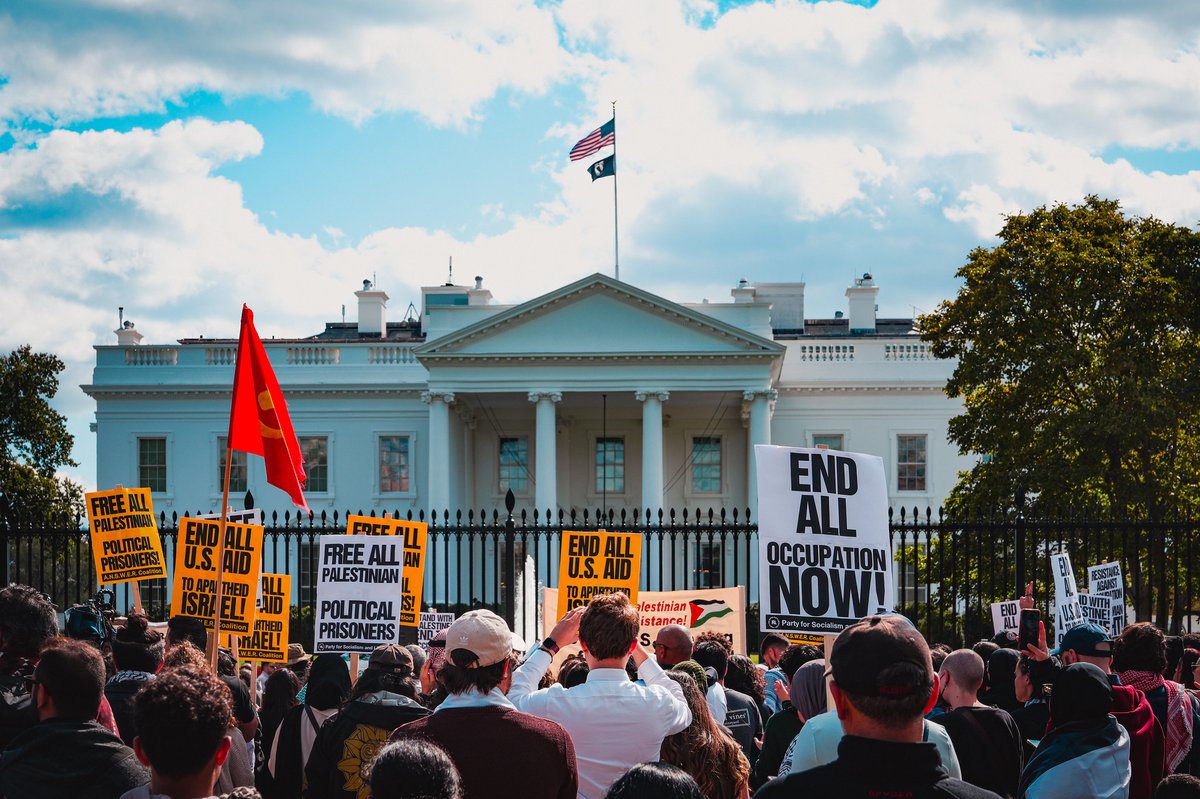The war in Gaza and at home

When House Speaker Mike Johnson rushed to Columbia University in late April to condemn student protests against the war and suggest that it was time to call in the National Guard, one couldn’t help but think of the Kent State University massacre. On May 4, 1970, members of the Ohio National Guard killed four unarmed students during a protest against the Vietnam War.
We are not at that point yet. But the crackdown on protests on college campuses across the country has reached Vietnam War-era levels of intensity. It is horrifying to see scenes like the one in which an economics professor was thrown to the ground by police at Emory University in Georgia and the Republican governor of Texas, Greg Abbott, Crow about the use of state troopers to arrest students at the University of Texas at Austin because “these protesters belong in jail” and “anti-Semitism will not be tolerated in Texas.”
The right-wingers want to divert public outrage from the horrific civilian death toll in Gaza to the protests at US universities. In a video message in April, Israeli Prime Minister Benjamin Netanyahu compared the anti-war demonstrations at universities to the Nazi rallies in Germany in the 1930s.
We’ve seen this kind of distraction before. When the murder of George Floyd by police officers in Minneapolis, Minnesota, shocked the nation in 2020, Fox News and Republican politicians quickly switched gears and ran exaggerated stories about rioters wreaking havoc, even though the vast majority of Black Lives Matter protests were peaceful. They managed to shift the conversation from police violence and systemic racism back to “law and order” so they could continue the repression.
Now we have an authoritarian Republican presidential candidate arguing before the U.S. Supreme Court that he should be allowed to murder his political rivals with impunity, stoking a panicked cry for public safety is helping to set the stage for Donald Trump’s dream of martial law.
Anti-Semitism—the charge used to justify the campus raids—is a real phenomenon. But it is certainly not the most prominent feature of the anti-war movement. Buried beneath Abbott’s post on X about arresting University of Texas students and kicking out “anti-Semites” is a barrage of hate speech about Jews and a meme of a man several commenters claim is Abbott’s “master”—a guy in a wheelchair wearing a yarmulke and kissing the Western Wall. These commenters, many of whom want Abbott to stop taking orders from “the Jews” and instead send police officers to arrest “illegals” at the southern border, appear to be the same neo-Nazi types Trump has called “very fine people.”
It is also true that there are anti-Semitic elements in the protest movement. Khymani James, the protest leader at Columbia who ranted about killing Zionists in a video earlier this year, has become Exhibit A and the subject of massive media coverage. He later retracted his own comments, and he and other student protest leaders said the comments were not representative of the movement as a whole. But this and many other incidents in which Jewish students have been singled out in class, urged to defend Israel and the war, or booed on campus understandably make Jewish students feel like they are operating in a hostile environment.
But it is a grotesque exaggeration to claim that peace activists on campus in general are a threat to the safety of Jewish students and must be suppressed with force. Inciting fear against antiwar protesters is akin to the widespread right-wing claim that the immigrants who are harvesting crops, milking cows, and cleaning hotel rooms across the country are dangerous “military-age men” “invading” the United States.
How can we keep a clear head in these dangerous, overstimulated times? It helps to have a historical perspective.
I recently finished reading historian Doris Kearns Goodwin’s fascinating memoirs. An Unfinished Love Story: A Personal Story of the 1960sIn it, Kearns Goodwin describes her journey through the same kinds of political and cultural conflicts we experience today.
Weaving personal and political history, she traces our country’s journey – from the bright optimism of the civil rights movement and the war on poverty, through the dark days of the assassinations of the Reverend Martin Luther King Jr. and Robert F. Kennedy, to the horror of the Vietnam War and the brutal backlash of youth culture that led to the presidency of Richard Nixon.
It is touching to read of the idealism of the early 1960s, and devastating to feel the weight of the subsequent descent into disillusionment and violence in that decade.
Kearns Goodwin describes how she researched the book with her late husband, Richard Goodwin, using his extensive document collection. He was the chief speechwriter and confidant of Presidents John F. Kennedy and Lyndon B. Johnson, as well as candidates Eugene McCarthy and Robert F. Kennedy, during their antiwar campaigns.
Goodwin was the one who wrote the stirring speech Johnson gave in 1965, urging Congress to pass the Voting Rights Act. The speech ended with a line from the civil rights anthem “We Shall Overcome.” He later broke with Johnson over Vietnam.
At the 1968 Democratic Party Convention in Chicago, Goodwin, who was then working for anti-war activist McCarthy, witnessed violent attacks by Chicago police on demonstrators, passersby and journalists.
In her book, Kearns Goodwin quotes reporter Jack Newfield, who met Richard Goodwin in the hotel lobby during the convention. “The ashen stub of a cigar protruded from his exhausted face and he muttered, ‘This is just the beginning. This will go on for four more years.'”
Later that evening, Hubert Humphrey defeated McCarthy and became the Democratic presidential nominee. Television coverage painted a divided picture, writes Kearns Goodwin: “On one side, the riot at the convention, with cheers and boos in equal measure; on the other, doctored footage of the carnage earlier in the evening, the sight of bodies cowering under police batons, the sounds of screams and sobs. Humphrey won the nomination on the first ballot, but that evening Theodore White’s notes read: “‘The Democrats are finished.'”
And that is exactly what happened. The Vietnam War, whose colossal losses the Johnson administration and the Pentagon had already recognized, lasted for another seven years.
This year, Republicans would be delighted if the 2024 Democratic Convention in Chicago saw clashes between police and protesters like in 1968. Chaos, violence and division are the perfect medium for Trump. And it is a fantasy of the right that the “culture war” politics that Republicans are stoking would lead to actual bloody conflict. It is important to resist this madness.
It is almost impossible today to identify with the ambitious optimism of the 1960s regarding American democracy. Even then, it was marked by willful ignorance – as the author James Baldwin describes in Next time the fire as “the collection of myths that white Americans cling to: that their ancestors were all freedom-loving heroes, that they were born in the greatest country the world has ever seen, or that Americans are invincible in battle and wise in peace.”
From the beginning, there was great cognitive dissonance among the citizens of a nation founded on the principle of equality and a slave economy. Even as the idealistic young Goodwin worked for Kennedy’s Peace Corps and the Alliance for Progress in Latin America, U.S. foreign policy supported the interests of big business, including by violently repressing popular movements in other countries while claiming to defend democracy around the globe. But the Goodwins were not the only ones who believed that young, idealistic Americans could change the world for the better. In some ways, they did, such as with civil rights and poverty relief programs and, ultimately, ending the Vietnam War.
Today, after Vietnam and Watergate and Iraq and Afghanistan and George Floyd and Gaza, it has become impossible to restore the deluded American innocence of the early 1960s. That cheerful, hands-on optimism has turned to cynicism on many on the left, and on the right to Trump’s angry, defensive white nationalism, which constantly harps on the idea of making America great again. America’s greatness can no longer be taken for granted, no matter how many protest camps are cleared out.
Kearns Goodwin worked for Johnson and developed a highly sophisticated sense of his immense talents and weaknesses; she wrote his biography, as well as biographies of Abraham Lincoln, Teddy Roosevelt, and Franklin and Eleanor Roosevelt. She looks at history from a distance. This was also true of her husband, of whom she describes movingly at the end of his life how he overcame his own discouragement when he realized how short the United States had been and how many changes had occurred in his life.
“Too often, memories of assassinations, violence and social unrest have obscured the greatest illumination of the 1960s: the spark of communal idealism and faith that ignited social justice and love for a broader vision of America,” writes Kearns Goodwin.
It is a helpful reminder that this hopeful vision lives on even in the darkest of times.



